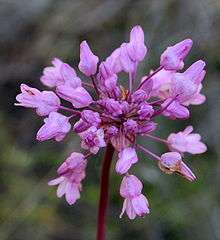Dichelostemma
| Dichelostemma | |
|---|---|
 | |
| Dichelostemma volubile | |
| Scientific classification | |
| Kingdom: | Plantae |
| Clade: | Angiosperms |
| Clade: | Monocots |
| Order: | Asparagales |
| Family: | Asparagaceae |
| Subfamily: | Brodiaeoideae |
| Genus: | Dichelostemma Kunth[1] |
| Type species | |
| Dichelostemma congestum (Sm.) Kunth[2] | |
| Synonyms[2][3] | |
| |
Dichelostemma is a genus of North American plants closely related to the genus Brodiaea and sometimes regarded as part of that group.[4][5]
Dichelostemma is classified in the cluster-lily subfamily within the asparagus family.[6] in the latest Angiosperm Phylogeny Group classification (2009).[7] Older sources often placed it in the lily family; earlier versions of the APG classifications used the family Themidaceae.
The genus is native to the North America, especially in northern California, but also east to New Mexico and north to British Columbia and south into northwestern Mexico.[4][8]
These plants grow from perennial corms that produce a raceme or umbel-like inflorescence. The flowers are bell- or tube-shaped and produce capsules with black seeds. The name, from the Greek for "toothed crown", refers to the stamen appendages.
Diversity
- Dichelostemma capitatum (Benth.) Alph.Wood – Blue Dicks - USA (OR CA NV UT AZ NM), Mexico (Baja California, Baja California Sur, Sonora)
- Dichelostemma congestum (Sm.) Kunth - Ookow - Canada (BC), USA (WA OR CA)
- Dichelostemma ida-maia (Alph.Wood) Greene - Firecracker flower - USA (CA OR)
- Dichelostemma multiflorum (Benth.) A.Heller - USA (CA OR)
- Dichelostemma volubile (Kellogg) A.Heller - USA (CA OR)
- Cultivars
- Dichelostemma 'Pink Diamond' - probably D. ida-maia × D. congestum (sometimes called Dichelostemma congestum).
References
- ↑ Kunth, Karl Sigismund. 1843. Enumeratio Plantarum Omnium Hucusque Cognitarum 4: 469–470 in Latin
- 1 2 Tropicos, Dichelostemma Kunth
- 1 2 Kew World Checklist of Selected Plant Families
- 1 2 Flora of North America, Vol. 26 Page 328 Dichelostemma Kunth, Enum. Pl. 4: 469. 1843.
- ↑ Jepson treatment
- ↑ Stevens, P.F., Angiosperm Phylogeny Website: Asparagales: Brodiaeoideae
- ↑ Chase, Mark W. & Reveal, James L. (2009), "A phylogenetic classification of the land plants to accompany APG III", Botanical Journal of the Linnean Society 161 (2): 122–127, doi:10.1111/j.1095-8339.2009.01002.x
- 1 2 Biota of North America Program 2013 county distribution maps
- ↑ The Plant List search for Dichelostemma
| Wikimedia Commons has media related to Dichelostemma. |
